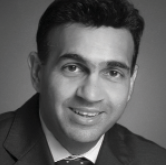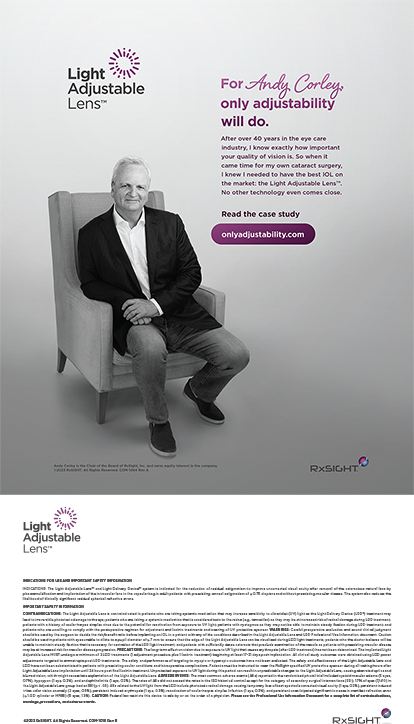DO YOU BELIEVE THAT PERFORMING POSTERIOR OPTIC CAPTURE SHOULD BE ROUTINE IN ADULT CATARACT SURGERY?

John J. DeStafeno, MD
• Chester County Eye Care, West Chester, Pennsylvania
"Surgeons should be familiar with all optic capture techniques and perform them when necessary. The routine use of posterior optic capture (POC) in adults would indeed be a paradigm shift. Although there are studies supporting the safety and efficacy of POC, will it truly be superior? And, will surgeons readily adopt this technique? Current surgical techniques have low complication rates, and posterior capsular abnormalities are effectively treated with Nd:YAG laser capsulotomy—a procedure familiar to and easily mastered by surgeons.
The largest barrier for routine use of POC is the steep learning curve. Anterior capsulotomy is arguably the most difficult skill to master in cataract surgery. Size, uniformity, centration, etc., are all essential for a safe and effective surgery. These attributes may be even more important for POC. An irregular posterior capsulotomy may lead to lens tilt, inability to maintain the lens capture, decentration, and the possibility of lens prolapse anteriorly in the event of future posterior segment surgery. IOL exchanges may be more challenging with an open posterior capsule, despite an intact hyaloid face.
In ophthalmology, we have a never-say-never attitude, and this has led to some of our most significant advances. POC may very well be one of these advances—but is it ready for prime time? Further studies will increase our understanding and determine if there are exponential benefits to this technique.”

John A. Hovanesian, MD
• Harvard Eye Associates, Laguna Hills, California
"POC presents many benefits to patients but a number of challenges to surgeons. Even the most deft among us may feel a visceral discomfort with an open posterior capsule. In order to ask our colleagues to overcome this aversion and begin routinely performing posterior capsulotomies, we need to offer them a set of techniques and instrumentation that can be mastered quickly, even by residents. Such methods would have to predictably create a centered, continuous, and round posterior opening while preserving the anterior hyaloid every single time. At this time, I do not believe such instruments exist, or they are not easily derived from existing devices designed for anterior capsulotomy (femtosecond laser, Zepto [Mynosys], etc.). Until we have such tools and techniques, I believe POC will remain a worthwhile aspiration for many and a niche technique practiced by a committed few.”

Jodhbir S. Mehta, BSc(Hons), MBBS, PhD, FRCOphth, FRCS(Ed), FAMS
• Singapore National Eye Centre, Singapore
"POC is certainly an interesting concept, and there is no doubt that it has a place for certain groups of patients (eg, pediatric patients and patients with posterior capsular plaques). The more controversial question is: Should we be doing it routinely in every adult cataract case?
The major limitation to its widespread acceptance, apart from the learning curve and fear of vitreous complications (although this has been reported to be low), is that there must be a clear benefit to the procedure over alternatives. Long-term studies would have to show the benefits—both visual and economic—to persuade surgeons to take this extra step in the procedure that may lengthen surgical time. These data may already exist because POC has been performed by some surgeons for more than a decade.
The concept of effectively fixing the lens position could offer more predictable biometric calculations of lens power, which would certainly garner interest among surgeons to start performing POC, especially for toric IOL implantation. The increasing use of microscopes incorporating intraoperative OCT may also improve our appreciation of the anatomy of Berger space, and this understanding may offer guidance in reducing the learning curve of POC. Another possibility would be to optimize POC creation with the use of a femtosecond laser; however, this would require nomogram optimization with respect to Z-axis depth. I like the concept, and I will certainly explore it in more detail, especially with some of the new tools we have available.“

Kevin M. Miller, MD
• David Geffen School of Medicine at UCLA, Jules Stein Eye Institute, Los Angeles
"Deliberately puncturing or tearing a posterior capsule to eliminate posterior capsular opacification is not a new idea. It has been done in pediatric cataract surgery for decades. It has been performed in postvitrectomy and other eyes with dense central posterior capsular plaques for years. It has been popularized in Europe by Marie-José Tassignon, MD, with her novel Bag-in-the-Lens (BIL, Morcher; not FDA approved) IOL design.
Whether it is better to place the entire IOL in the capsular bag or to position the haptics in the bag or sulcus and the optic behind the posterior capsule is debatable. Both approaches have merit. The real issue is the risk of any approach that violates the posterior capsule versus the known risk associated with keeping the capsule intact.
It is doubtful that a posterior capsulorhexis could be performed routinely by the average cataract surgeon without vitreous loss. Perhaps the technique can be taught, but I have done enough cases to know they are tricky. So one must weigh the increased risk of retinal tears and detachments, cystoid macular edema, and endophthalmitis—none of which is trivial—if a vitrectomy is needed against the known risk of posterior capsular opacification, which has a readily available and fairly inexpensive treatment.
If a large, prospective, multisurgeon clinical trial could be conducted, with each patient serving as his or her own control (preserving the posterior capsule in one eye and opening the posterior capsule in the other eye), and if the complications were substantially equivalent between eyes, then I could be swayed to offer patients a primary posterior capsulorhexis with or without POC for the obvious immediate and enduring clinical benefit it would provide.”

Tobias H. Neuhann, MD, FEBOS-CR
• AaM Augenklinik am Marienplatz, Munich, Germany
"I really love this topic because the question touches not only the visual acuity outcome but also the quality-of-life results for our patients. Will primary POC become a routine practice? I’m not very confident that it will, but perhaps I’m too pessimistic.
I published and presented on the subject of anterior optic capture (AOC) at the 1991 ASCRS Annual Meeting, using the term rhexisfixation. Enthusiasm at the time was quite limited. Nevertheless, the video was awarded the runner-up prize in the category of surgical techniques, and I was very proud and happy with this award.
Then it took more than 13 years before Gimbel published a variety of different optic capture techniques, while other surgeons such as Koch, Kohnen, Menapace, and others reported good and sometimes amazing results with different techniques of POC. Now, 27 years later, there is the question of why a paradigm shift toward POC is taking so long.
The arguments of Lisa Brothers Arbisser, MD, in this issue of CRST are well presented and understood, and her article in this issue summarizes all the important arguments for POC perfectly. However, the international and especially the European market provide implants outside the normal IOL market, which, from my perspective, are much more suitable to achieve the outcomes that POC provides.
The BIL is a remarkable implant that respects the Berger space and the anterior hyaloid. I have used the BIL since 2003 and have not experienced secondary cataract or secondary glaucoma in patients implanted with the lens. It simply does not happen. Another major advantage of the BIL design is that the implant can be exchanged years later because the two capsule layers are fused together but do not stick in the groove of the lens haptic. The technique is similar to changing the tires on a car.
We also have two other new types of IOL available in Europe that use the rim of the anterior capsulorhexis as the main site of fixation, thus eliminating the never-ending questions regarding negative dysphotopsia, stray light, and effective lens position. How many surgeons are using these new IOLs?
I can ask a question similar to the one at the top of this column: How long will it take for primary AOC to become routine practice? I think the main reason for not adopting or accepting POC or AOC is the missing scientific proof that these new techniques give the patient a major advantage in short- and long-term quality-of-life results. As long as these techniques cannot prove their superiority to routine surgery, only a small group of skillful surgeons will provide them for their patients.”




